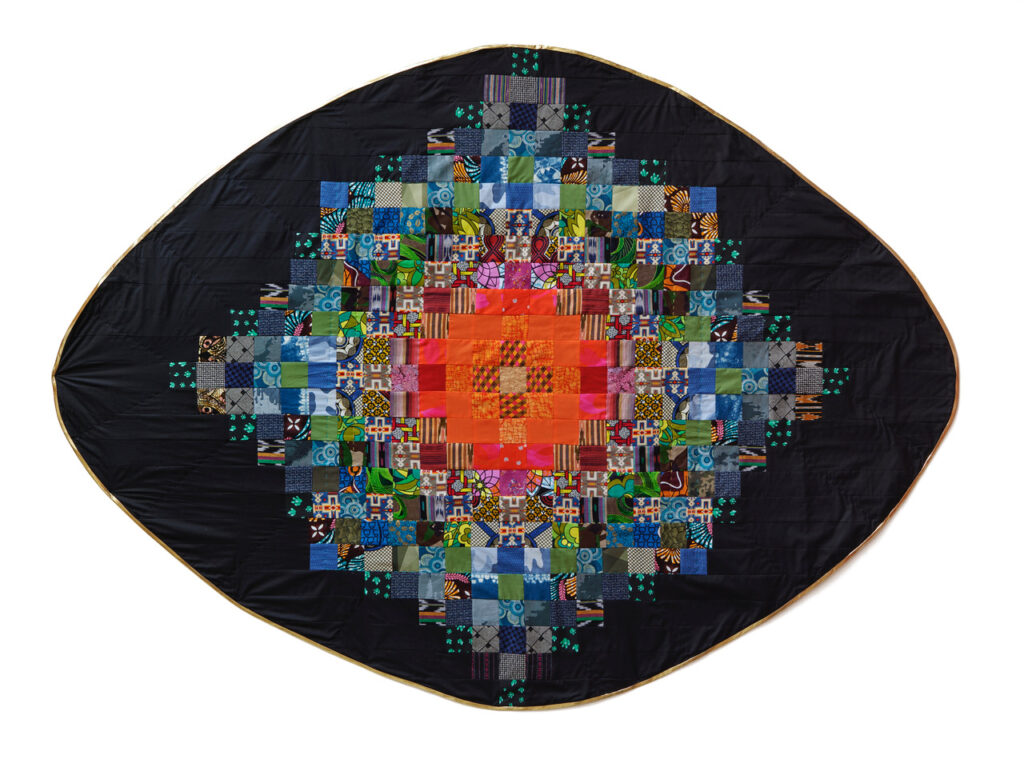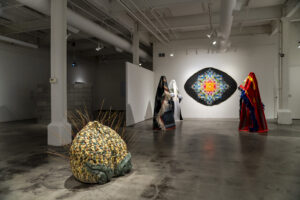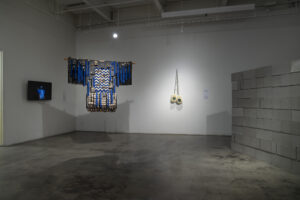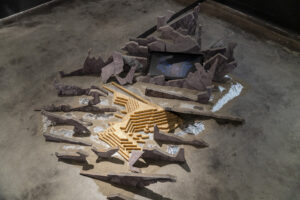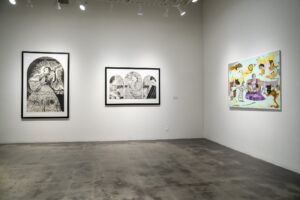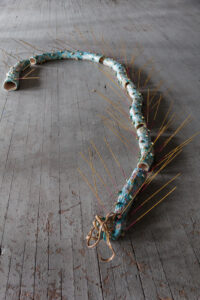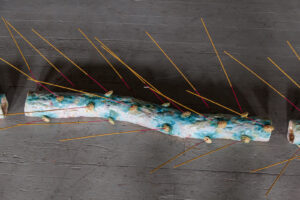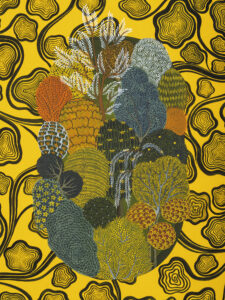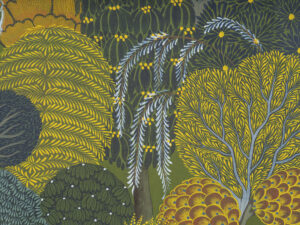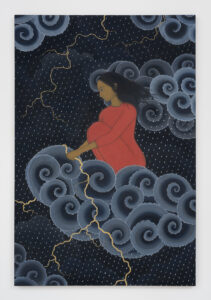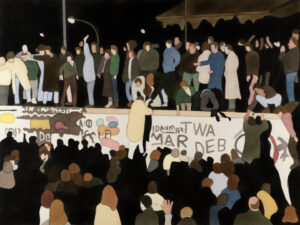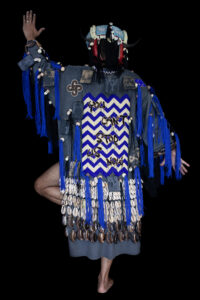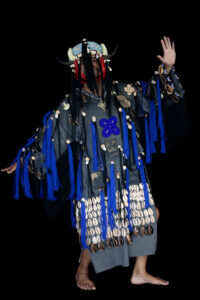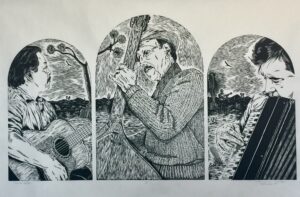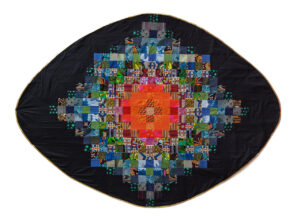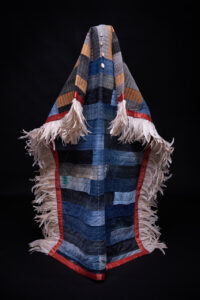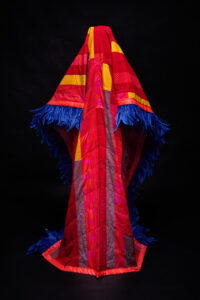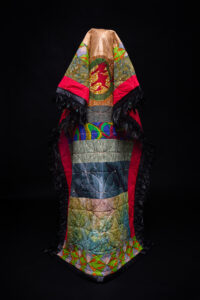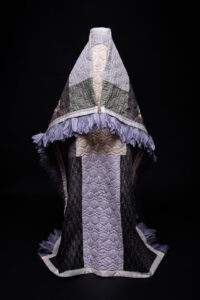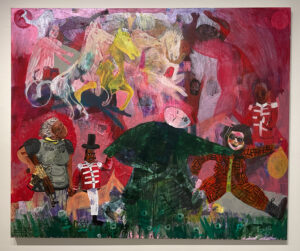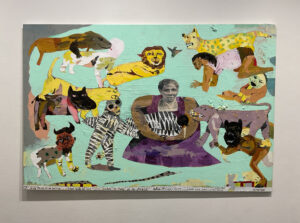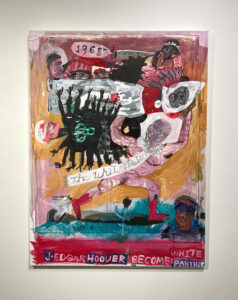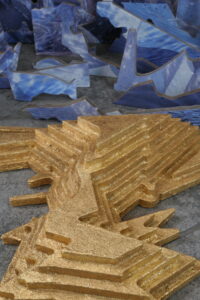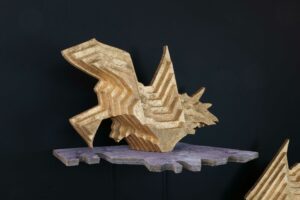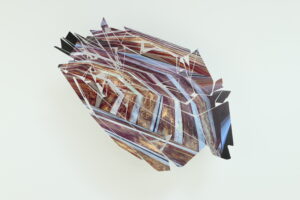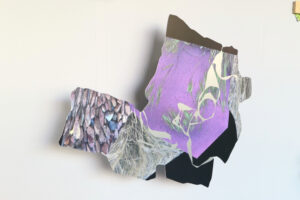Under the Sky
Kala Gallery will be closed on July 4, 2024.
Closing Reception & Artist Talk: Saturday, June 29, 2-4pm
Kala Gallery is excited to present Under the Sky, an exhibition celebrating Kala’s 50th anniversary featuring works by former Kala fellows and honored artists: Demetri Broxton, Kota Ezawa, Cathy Lu, Adia Millett, Emmanuel Montoya, Gregory Rick, Rupy C. Tut, and Minoosh Zomorodinia.
In 1974, artists Archana Horsting and Yuzo Nakano started Kala Art Institute to create a space to share artmaking equipment and exchange ideas. Kala began with a single etching press and a hot plate in a garage in San Francisco. Soon eleven artists from seven countries joined this growing community, and it became clear that a bigger facility was needed. After a brief stint on Adeline Street in Berkeley, in 1979 Kala established homebase at our current location in the Heinz building in West Berkeley.
The name Kala embraces the spirit of cultural exchange. The word “Kala” has many meanings in different languages. In Sanskrit it means arts; in Greek, good and beautiful; in Japanese, sky and emptiness; in Hawaiian, sun, gold, and money; in Turkish, fortress; and in Hebrew it means bride. True to our name, Kala embraces, nurtures, and amplifies a multiplicity of voices working across many forms, often intersecting in novel, unforeseen, and meaningful ways.
Over the years artists-in-residence from all over the world have made work at Kala’s studio, shared conversation and techniques, exhibited work in the gallery, and taught workshops for the community. Grounded by the spirit of creative exchange, Kala has grown steadily over the decades.
Since the beginning, Kala has encouraged artists to experiment, take risks and explore new techniques. Now in our 50th year, Kala is a space that continues to bring diverse ideas and people together to share creative resources and inspiration. Kala is committed to connecting artists to the community and the community to artists so together we can better understand our world.
The exhibition Under the Sky brings artists together to revisit Kala’s core values. These values include creating a sense of belonging, embracing community wisdom, learning from one another, and building a caring, creative community.
Artists in the exhibition celebrate and reflect on their cultural heritage and related crafts, historical events, and collective memory and wisdom. Their work provides a window into contemporary issues through layers of past histories and imagined futures. The work explores ruminations about how to move towards a more connected and mutually supportive future. Under the sky the world can be seen as a united entity. Boundaries and barriers are created out of fear and uncertainty, a desire to protect or keep separate, and even to suppress others.
In his Jerusalem Prize acceptance speech, novelist Haruki Murakami mentioned that “Between a high, solid wall and an egg that breaks against it, I will always stand on the side of the egg.” The egg here reminds us of the role artists and their work can play. Artists carry important messages and unique perspectives through their work, often breaking through walls and barriers with creative insight. Artists embrace the vulnerability that comes with this challenge. They courageously breach the norms, challenge the expected, inspire collaboration and compassion, and lift the voices of those stuck between walls and hard places.
As we celebrate Kala’s rich history and current vibrant culture, we also consider what’s to come. At Kala, we hope to continue to be a place where artists and communities come together, create, learn from one another, and expand connections.
Demeti Broxton is a mixed media artist of Louisiana Creole and Filipino heritage who was born and raised in Oakland, CA. His textile sculptures reflect his connection to the sacred art of the Yoruba people of Nigeria, the beading traditions of the New Orleans Mardi Gras Indians, and his love of hip hop and graffiti. His work is an ongoing investigation of cultural continuities from Africa to America and he is particularly interested in how these ancient cultural forms find their way into mainstream culture.
Kota Ezawa samples imagery from a broad range of sources, including news media, popular cinema, and the history of art, which he then distills into flattened landscapes of pure form. For his installation in the exhibition THERISEANDFALLOFTHEBERLINWALL, a video projected onto a freestanding concrete wall, Kota selected images from widely available newsreel footage of construction and dismantling of the Berlin wall. He reproduced these images as watercolors and then weaved them into a condensed animated narrative.
Cathy Lu’s work manipulates traditional Chinese objects and imagery as a way to deconstruct the assumptions we have about Asian American identity and cultural authenticity. By creating ceramic sculptures and installations, Cathy explores what it means to be both Asian and American, while not being entirely accepted as either. Unpacking how experiences of immigration, cultural hybridity and assimilation become part of the larger American identity is central to her work.
Adia Millett’s art honors the history of domestic craft, abstraction, and architecture, while being inspired by afro futurism, emotional resilience and the preservation of our land. Her work ranges from painting, quilting, glass, video, sculpture, to installation. Investigating the fragile interconnectivity among all living things, she deconstructs images, ideas and materials to shed light on the multifaceted and complex parallels between the creative process and the nature of personal identity.
Emmanuel Catarino Montoya is a descendant of Apache and Mexican heritages, who was born in Corpus Christi, Texas. He has lived and worked in the San Francisco Bay Area since 1964. Emmanuel is best known for his dynamic relief prints. His work is influenced by the Chicano movement of the late 1960 & 70s and also by the master printmakers and muralists of contemporary Mexico and Latin America. He has taught printmaking, mural painting and drawing in diverse venues ranging from community-based organizations, to university classrooms and the California State prison system.
Gregory Rick’s paintings challenge moments in American history by offering a more complete story or an alternate reality to specific moments that represent subjugation and control, division and inequality and the promotion of racism and classism. His paintings depict counters to consequential events in American history becoming prayers of resistance in magical realism, and Afrofuturism that take the history and tell a different account, a version where the historically marginalized group or loser carries the day, wins the battle and ultimately changes history.
Rupy C. Tut is a painter dissecting historical and contemporary displacement narratives around identity, belonging, and gender. As a descendant of refugees and a first generation immigrant, Rupy’s family narrative of movement, loss, and resilience is foundational to her creative inquiries. Rupy studied calligraphy and Indian miniature painting at the Prince’s Foundation School of Traditional Arts, London in 2016. Her artistic practice expands, innovates, and reframes the traditions of Indian miniature painting. She mixes her own pigments and creates her paintings on hemp paper and linen.
Minoosh Zomorodinia is an Iranian-born interdisciplinary artist, educator, and curator based in the Bay Area, who explores the complex relationship between humans, nature, and technology through her work. Utilizing psychogeography in her daily rituals, she captures the passage of time in different environments. Her objectives include redefining borders, confronting the colonization of land, and highlighting the profound interconnectedness between humans and nature. She focuses on mapping in the digital age, further blending the physical with the virtual in her exploration of space and identity.

